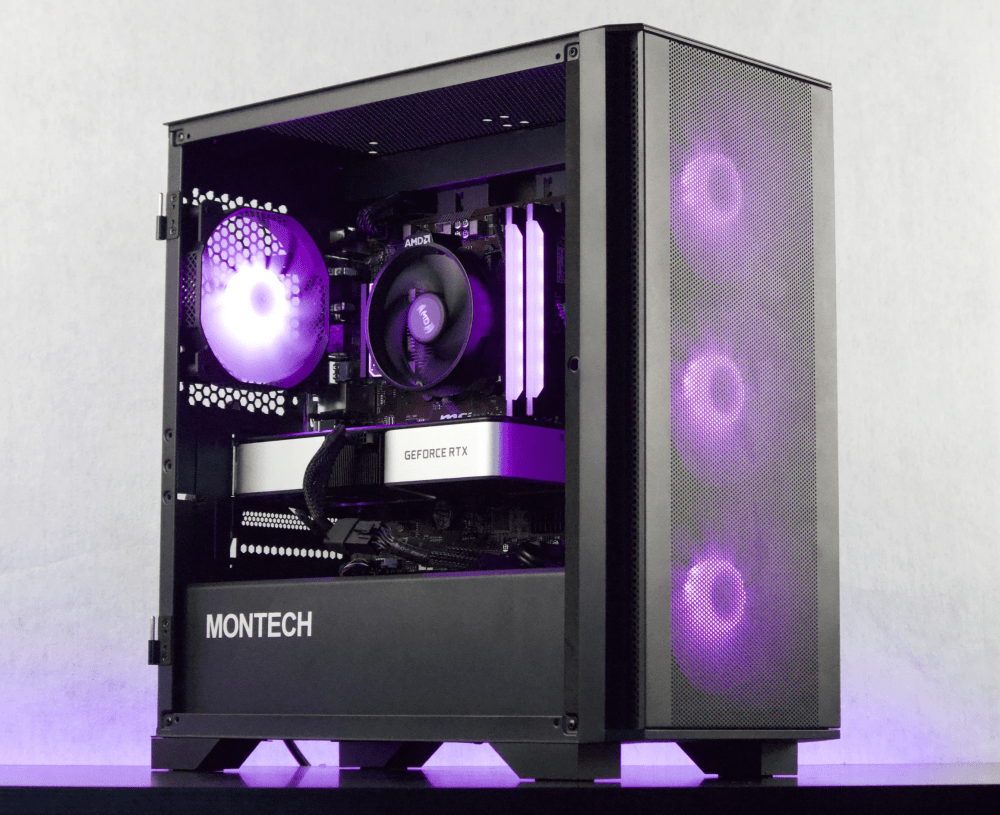Welcome to our blog post on how to replace thermal paste on a GPU. If you're a gaming enthusiast or someone who heavily relies on their graphics card for demanding tasks, it's important to understand the significance of thermal paste in maintaining optimal performance and preventing overheating. In this guide, we will take you through the step-by-step process of replacing thermal paste on your GPU, ensuring that you can keep your graphics card running smoothly and efficiently.
Before diving into the procedure, we will discuss why replacing thermal paste is necessary and the tools you'll need for the job. Understanding the structure of your GPU is also crucial in order to navigate the process effectively.
Next, we will explore how to safely remove the old thermal paste from your GPU. We'll also highlight the signs that indicate your GPU is in need of a thermal paste replacement. Throughout this section, we'll provide precautions to ensure that you don't damage your graphics card during the process.
Once the old thermal paste has been removed, we'll guide you through the process of applying the new thermal paste. We'll discuss how to choose the right thermal paste and demonstrate proper application techniques to ensure an even spread. This step is crucial for maximizing heat transfer efficiency and preventing overheating issues.
After applying the thermal paste, we'll show you how to reassemble your GPU and run tests to ensure that the installation was successful. Properly putting your GPU back together is essential to avoid any potential complications. Running tests will give you peace of mind and allow you to confirm that the new thermal paste is working effectively.
Finally, we'll provide tips on maintaining your GPU after the thermal paste replacement. Taking proper care of your graphics card will ensure its longevity and continued optimal performance.
By the end of this guide, you'll have the knowledge and confidence to replace the thermal paste on your GPU, improving its cooling capabilities and preventing potential damage. So, let's get started on this essential maintenance procedure to keep your GPU running at its best!
Understanding the Importance of Thermal Paste in a GPU
Thermal paste, also known as thermal compound or thermal grease, plays a crucial role in the cooling system of your GPU. It acts as a medium between the graphics processing unit (GPU) and the heat sink, facilitating the transfer of heat away from the GPU to the cooling system.
Heat is a natural byproduct of the intensive operations performed by the GPU. Without proper heat dissipation, the temperature of the GPU can rise to dangerous levels, leading to performance issues, system instability, and potentially even permanent damage. This is where thermal paste comes into play.
The primary function of thermal paste is to fill in microscopic gaps and imperfections between the GPU die and the heat sink. These imperfections can prevent direct contact between the two surfaces, creating air pockets that hinder heat transfer. By filling in these gaps, thermal paste improves the conductivity of heat from the GPU to the heat sink, ensuring efficient cooling.
Thermal paste is typically composed of a mixture of metal oxides, ceramics, and silicone compounds. These materials possess high thermal conductivity, allowing heat to flow more effectively. Additionally, thermal paste also helps to eliminate air bubbles or voids that can act as insulators and impede heat transfer.
Over time, the thermal paste on your GPU can degrade and dry out, reducing its effectiveness in facilitating heat transfer. This can lead to elevated temperatures and decreased performance. Therefore, it's essential to periodically replace the thermal paste to maintain optimal cooling performance and prevent potential damage to your GPU.
Now that you understand the importance of thermal paste in a GPU's cooling system, let's move on to the next section: "Preparation Before Replacing Thermal Paste."
Preparation Before Replacing Thermal Paste
Before diving into the process of replacing thermal paste on your GPU, it's important to properly prepare yourself and gather the necessary tools and materials. This section will guide you through the essential steps to take before starting the thermal paste replacement procedure.
Why Replacing Thermal Paste is Necessary
Understanding why thermal paste replacement is necessary will help you appreciate the importance of this maintenance task. As mentioned earlier, thermal paste degrades over time, losing its effectiveness in facilitating heat transfer. This can lead to increased temperatures, reduced performance, and potential damage to your GPU. By replacing the thermal paste, you can restore optimal heat dissipation and ensure the longevity of your graphics card.
Tools Required for the Procedure
To replace the thermal paste on your GPU, you'll need the following tools:
- Isopropyl alcohol (preferably 99% pure) and lint-free microfiber cloth: These will be used to clean the GPU and remove the old thermal paste.
- Thermal paste: Choose a high-quality thermal paste suitable for your GPU. There are various options available, such as silicone-based, metal-based, and ceramic-based thermal compounds.
- Screwdriver set: Depending on your GPU model, you may need a screwdriver to disassemble and reassemble the graphics card.
- Gloves and anti-static wrist strap: These will help prevent electrostatic discharge (ESD) damage to your GPU during the process.
It's important to ensure that you have all the necessary tools and materials before starting the thermal paste replacement procedure. This will help you work efficiently and minimize the risk of damaging your GPU.
Understanding the Structure of Your GPU
Before proceeding with the thermal paste replacement, it's essential to familiarize yourself with the structure of your GPU. Different graphics card models may have different designs and cooling mechanisms. Refer to the manufacturer's documentation or online resources to understand how your specific GPU is constructed and how the cooling system is implemented.
Identify the location of the GPU die, heat sink, and any additional components that may need to be removed for access. Understanding the structure of your GPU will allow you to navigate the replacement process smoothly and avoid any potential complications.
Now that you're prepared and equipped with the necessary knowledge and tools, let's proceed to the next section: "Removing the Old Thermal Paste from Your GPU."
Removing the Old Thermal Paste from Your GPU
Once you have prepared yourself and gathered the necessary tools, it's time to remove the old thermal paste from your GPU. This section will guide you through the process of safely and effectively removing the old thermal paste to prepare for the application of new thermal paste.
Signs Your GPU Needs a Thermal Paste Replacement
Before proceeding with the removal process, it's important to determine whether your GPU actually requires a thermal paste replacement. Look out for the following signs:
-
Increased temperatures: If you notice that your GPU temperatures are consistently higher than usual, even under normal load, it could be an indication that the thermal paste has degraded and needs to be replaced.
-
Performance issues: Overheating due to ineffective heat dissipation can lead to performance degradation, such as decreased frame rates in games or system slowdowns. If you're experiencing these issues, it's worth considering a thermal paste replacement.
-
Dust and debris buildup: If you notice a significant accumulation of dust or debris on your GPU or in the cooling system, it can impede heat transfer and worsen the effectiveness of the thermal paste. In such cases, cleaning the GPU and replacing the thermal paste may be necessary.
How to Safely Remove the Old Thermal Paste
Follow these steps to safely remove the old thermal paste from your GPU:
-
Power off your computer and disconnect it from the power source. This is crucial to prevent any electrical accidents or damage to your components.
-
Open your computer case and carefully remove the GPU from its slot. Refer to your computer's manual or online resources for guidance if needed.
-
Place the GPU on an anti-static mat or surface to prevent any ESD damage.
-
Use a screwdriver to remove any screws or fasteners that secure the GPU's heat sink or cooler. Take note of the screw locations and keep them safely aside for reassembly later.
-
Gently detach the heat sink or cooler from the GPU. Be cautious not to apply excessive force or twist the GPU, as this can cause damage.
-
Once the heat sink or cooler is removed, use isopropyl alcohol and a lint-free microfiber cloth to clean the GPU die and the heat sink surface. Dampen the cloth with isopropyl alcohol and gently wipe away the old thermal paste, ensuring that all residue is removed.
-
Repeat the cleaning process until both the GPU die and the heat sink surface are free from any traces of the old thermal paste.
-
Allow the GPU and heat sink to fully dry before proceeding to the next steps.
By following these steps, you can safely remove the old thermal paste from your GPU, preparing it for the application of fresh thermal paste. Now that the old thermal paste has been removed, let's move on to the next section: "Applying the New Thermal Paste on Your GPU."
Applying the New Thermal Paste on Your GPU
Now that you have successfully removed the old thermal paste from your GPU, it's time to apply the new thermal paste. This section will guide you through the process of choosing the right thermal paste, applying it correctly, and ensuring an even spread for optimal heat transfer.
Choosing the Right Thermal Paste
When it comes to selecting the thermal paste for your GPU, it's important to choose a high-quality product that suits your specific needs. Consider the following factors:
-
Thermal Conductivity: Look for a thermal paste with high thermal conductivity, as this will ensure efficient heat transfer between the GPU die and the heat sink. Thermal pastes with metal-based or ceramic-based compounds generally offer excellent thermal conductivity.
-
Consistency: Consider the consistency of the thermal paste. Some pastes are more viscous, while others are more liquid-like. Choose a consistency that is easy to apply and spreads evenly.
-
Compatibility: Ensure that the thermal paste is compatible with your GPU model. Check the manufacturer's specifications or online resources to confirm compatibility.
-
Longevity: Look for a thermal paste that offers long-term stability and durability. Some thermal pastes may dry out or degrade more quickly than others, requiring more frequent replacements.
Proper Application Techniques
Follow these steps to apply the new thermal paste correctly:
-
Take a small amount of thermal paste and place it at the center of the GPU die. The size of a pea or a grain of rice is usually sufficient. Avoid applying too much paste, as it can lead to excessive spreading and potential electrical shorting.
-
Use a card, such as a credit card or a dedicated thermal paste spreading tool, to spread the thermal paste evenly over the GPU die. Gently and evenly glide the card across the surface, ensuring that the paste covers the entire die without any excess.
-
Ensure that the thermal paste layer is thin and uniform. Thick or uneven layers can hinder heat transfer and may result in poor cooling performance.
Ensuring an Even Spread of Thermal Paste
To ensure an even spread of thermal paste, it's essential to properly reattach the heat sink or cooler to the GPU. Follow these steps:
-
Align the heat sink or cooler with the GPU, ensuring that the screw holes and mounting brackets line up correctly.
-
Slowly and evenly lower the heat sink or cooler onto the GPU, applying gentle pressure. Avoid applying excessive force, as it can cause damage to the GPU or result in an uneven spread of thermal paste.
-
Once the heat sink or cooler is in place, reattach the screws or fasteners, securing it to the GPU. Tighten the screws in a diagonal pattern to ensure even pressure distribution.
By following these steps, you can confidently apply the new thermal paste on your GPU, ensuring optimal heat transfer and cooling performance. Now that you've successfully applied the thermal paste, it's time to move on to the next section: "Reassembling Your GPU and Testing."
Reassembling Your GPU and Testing
After applying the new thermal paste on your GPU, it's time to reassemble the components and test the functionality of your graphics card. This section will guide you through the process of putting your GPU back together and running tests to ensure that the thermal paste replacement was successful.
Putting Your GPU Back Together
Follow these steps to reassemble your GPU:
-
Carefully align the GPU with its slot on the motherboard. Ensure that the connectors on the GPU align with the corresponding ports on the motherboard.
-
Gently insert the GPU into the slot, applying even pressure until it is fully seated. Be cautious not to force it or bend any components.
-
Use the screws or fasteners to secure the GPU in place. Refer to the manufacturer's instructions or online resources for the specific screw locations and tightening sequence.
-
Reconnect any power cables or additional connectors to the GPU, ensuring a secure and proper connection.
Running Tests to Ensure Proper Installation
Once your GPU is reassembled, it's important to perform tests to ensure that the thermal paste replacement was successful and that your graphics card is functioning correctly. Here are some recommended tests:
-
Stress Test: Use software such as FurMark or 3DMark to run a stress test on your GPU. This will push your graphics card to its limits and monitor its performance under heavy load. Pay attention to temperatures and stability during the stress test. If the temperatures remain within acceptable limits and the GPU maintains stability, it indicates a successful thermal paste replacement.
-
Temperature Monitoring: Utilize monitoring software, such as MSI Afterburner or HWMonitor, to monitor the temperatures of your GPU during regular usage or while running demanding applications. Ensure that the temperatures stay within acceptable ranges and that there are no sudden spikes or abnormalities.
-
Benchmarking: Run benchmarking software, such as Unigine Heaven or 3DMark, to compare the performance of your GPU before and after the thermal paste replacement. This will give you an indication of any performance improvements or changes.
Maintaining Your GPU After Thermal Paste Replacement
To ensure the longevity and optimal performance of your GPU after the thermal paste replacement, consider the following maintenance tips:
-
Regular Cleaning: Clean your GPU and its cooling system periodically to prevent dust and debris buildup. Use compressed air or a soft brush to remove any accumulated dust from the heat sink and fans.
-
Monitor Temperatures: Keep an eye on the temperatures of your GPU regularly, especially during intense gaming or heavy workloads. If you notice any abnormal temperature spikes or consistent high temperatures, it may indicate a need for further investigation or maintenance.
-
Check Thermal Paste: As thermal paste can degrade over time, it's recommended to check the condition of the thermal paste periodically. If you notice any signs of drying or degradation, consider replacing the thermal paste again.
By following these steps and performing regular maintenance, you can ensure that your GPU remains in optimal condition after the thermal paste replacement.
Congratulations! You have successfully reassembled your GPU and tested it to confirm the effectiveness of the thermal paste replacement. In the final section, we will conclude our guide and summarize the key points.
Conclusion
In conclusion, replacing the thermal paste on your GPU is a vital maintenance task that can significantly improve its cooling performance and prevent potential damage caused by overheating. By understanding the importance of thermal paste and following the proper procedures, you can ensure that your graphics card runs smoothly and efficiently.
Throughout this guide, we discussed the significance of thermal paste in facilitating heat transfer, the signs that indicate the need for a thermal paste replacement, and the tools required for the procedure. We also covered the steps involved in removing the old thermal paste and applying the new one correctly. Additionally, we explored the process of reassembling the GPU and running tests to verify the success of the thermal paste replacement.
Remember to choose a high-quality thermal paste that suits your GPU, ensure an even spread of the paste, and properly reassemble the components. Regularly monitor the temperatures of your GPU and perform maintenance tasks to keep it in optimal condition.
By following these guidelines, you can extend the lifespan of your GPU, improve its performance, and maintain a stable and cool operating temperature. If you have any doubts or concerns, always refer to the manufacturer's instructions or seek professional assistance.
Thank you for reading our comprehensive guide on how to replace thermal paste on a GPU. We hope that this information has been valuable and helpful to you. Take care of your GPU, and enjoy uninterrupted gaming or high-performance computing!
Looking to upgrade your GPU? Check out Jawa for killer deals on new and used graphics cards.





